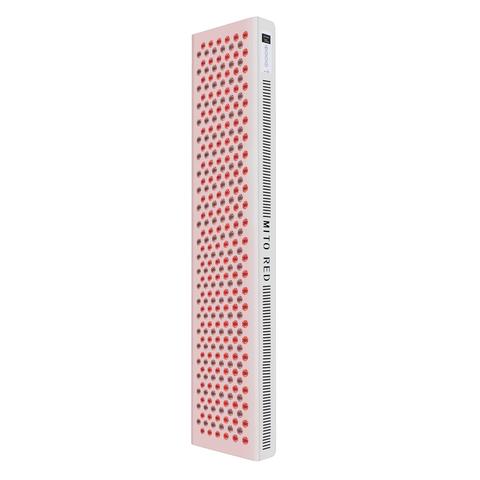Mito Red MitoPRO 1500 Review: An Extraordinary Panel For Ordinary People?
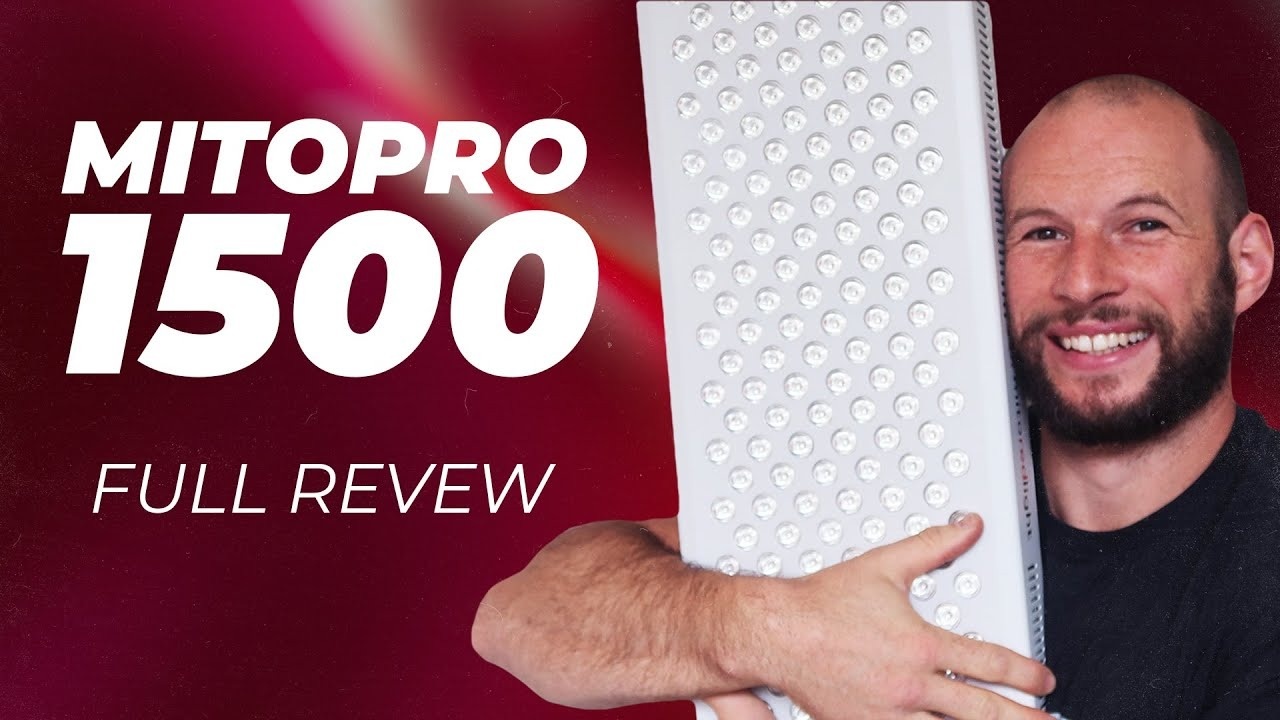
Red light therapy panels from Mito Red have traditionally been one of the best offerings on the market. In my 2019 review, for instance, they offered the best value panel that focuses on the basics.
The original panels had a great design, low EMF, were easy to use, and above all, were priced perfectly. Shipping and support were also great. The original Mito Red placed second in that 2019 review series.
Back then, Mito Red was a new company. Right now, Mito Red is on the market for a few years and has become very much established as one of the bigger players.
The company has recently released their new MitoPRO series. In this blog post, I'll review the biggest unit from that company, the MitoPRO 1500. Here you can see a picture of that panel:
I've heard some great testimonials from people and I've also used the panel myself for a few months.
If you're interested in getting a panel, use code ALEX and THIS link for a 5% discount. Under here I've summarized my findings about this panel:
Mito Red MitoPRO 1500 Review Summary
Pros:
- The panel is really tall for a body panel and has a good size.
- Included wavelengths - 630nm, 660, 830 and 850 - are very good.
- Amazing value according to different metrics. The price per LED is among the lowest out there and the price per Watt is the lowest of the panels I've reviewed so far.
- Decent power output, although not the highest in the industry
- Good beam angle with no hotspots. Power output is spread out very evenly at a 6-inch distance.
- The return policy & trial period are excellent. Within 60 days you can return your panel without paying a restocking fee if you're not happy. Of course, you do pay for shipping the panel back to the US.
Cons:
- The control panel could be simplified further - it's decent but not as good as some other panels out there.
- The panel is lacking bells & whistles. You don't get the extreme variety of pulsing options as in the LightpathLED, for instance, or the wireless function of the Joovv 3.0
- High shipping cost potential. Shipping costs to the UK or Australia are $100 USD+, although the US receives free shipping.
- Missing 810nm wavelength. I consider the 810 nm wavelength having some decent scientific backing. In my spectrometer testing, the 830 nm wavelength turned out to be 845, which is a bummer. Mito Red tells me that problem should be averted with current orders.
- A bit bland, although this could also be a "pro" - depending on whether you want a panel for an advanced biohacker or just one for the average guy or gal.
Want to buy a panel? Then use code ALEX and THIS link for a 5% discount. I get a small kickback from almost all red light therapy companies so I'm unbiased and you save some money - so it's a win-win for all involved.
Table Of Contents
Short On Time? Watch My Quick Review Video
Note: This 5-minute quick review is highly recommended watching if you're time-poor.
First Impressions And Unboxing
- My First Look At The Box After Receiving The Shipment
- The Exterior Look Of The Red Light Therapy Panel
- Other Ranges: The Original Range And MitoMOD Range
- What's Included In The Box
- MitoPRO 300, MitoPRO 750, And MitoPRO 1500 Differences
- Vertical And Horizontal Stand Options
- Price, Shipping, And Warranty
- 60-Day Return Policy With No Restocking Fee
- First Impressions And Unboxing Conclusion
Mito Red MitoPRO 1500 Full Review: An Excellent Panel At Excellent Value?
- Physical Properties: Size, Power Connection, And Color
- Weight Of The Red light Therapy Panel
- Instruction Manual Quality
- Spectrometer Wavelength Testing
- Mito Red's Response To My Testing Results
- Power Output (Irradiance) Testing & Wattage Draw From Power Outlet
- Hotspot Testing
- Value Calculation: USD Per LED And USD Per Watt
- Electrosmog (EMF): Radio Waves, Magnetic Fields, Electric Fields
- Sounds And Noise Pollution Exposure
- Flicker And Pulsing Levels
- Ease Of Setting Up The Panel
- My Experience After A Few Weeks Of Use
- MitoPRO Comparison To Mito Red Original Series and MItoMOD Series
- Comparing The MitoPRO To Competitors (PlatinumLED BioMax, LIghtpathLED Large Multiwave Pulsed, Etc)
Concluding Likes & Dislikes After Rigorous Testing
Finishing Thoughts: An Extraordinary Panel For Ordinary People
Note on blog review below:
If there's a slight discrepancy between the video reviews and my blog, that is because I've avoided including the same information twice. For instance, some of the information on the price of shipping of my full review is included in the price section of my first impressions video. I've thus made the blog internally consistent instead of repeating the same information found in the videos twice
Short On Time? Watch My Quick Review Video Below
If you don't have 25 minutes to read my full review, then consider watching the 5-minute video below, which gives you all the important takeaways:
First Impressions And Unboxing
In this section, I'll consider my first impressions and unboxing for the Mito Pro 1500 (discount code ALEX saves 5%).
This first impressions section was literally created based upon the box of the red light therapy panel arriving at my doorstep. I thus give you my raw and unfiltered onion about what my experience with the panel is.
If you'd rather view a YouTube video that I shot about the first impressions & unboxing topic, consider the one below:
Below I've transcribed the contents of that video, so either by watching the video or by reading my blog post will you get fully informed about my opinion.
My First Look At The Box After Receiving The Shipment
As you can see, the box for the Mito Pro 1500 that arrived at my house is huge:

Notice that there is some nice Mito Red branding on the box itself. For that reason, you'll always recognize the product arriving at your doorstep comes from Mito Red. Some other red light therapy companies don't provide the branding on the box itself, which can then lead to confusion because you don't know which product you're unpacking.
The box is very easy to open with a pair of scissors:
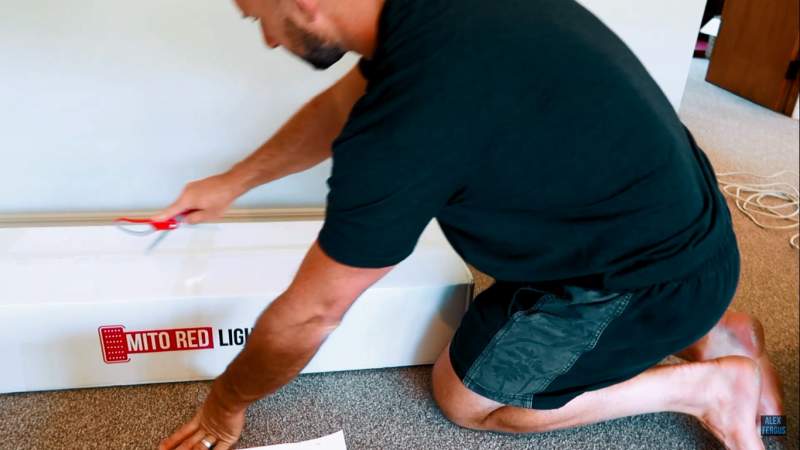
After you open the panel, you'll be met with a thin layer of foam. Behind that foam you find the panel:
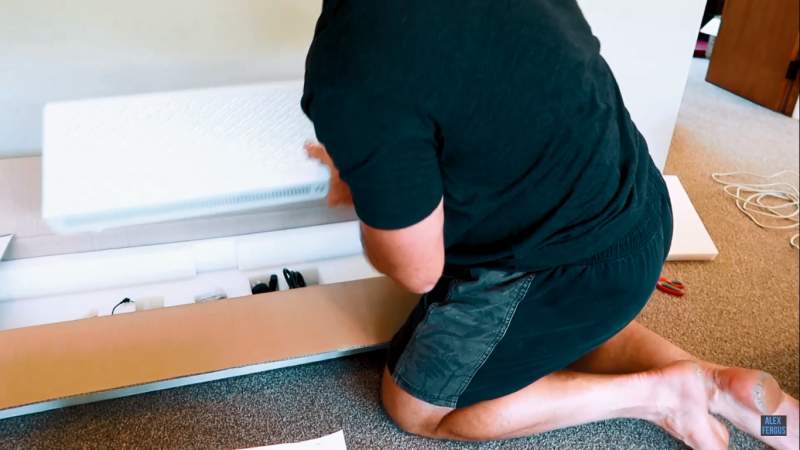
As you can see, many of the accessories are included at the bottom of the box. You can get a better view of these accessories here:

Next up, let's take a look at the panel itself:
The Exterior Look Of The Red Light Therapy Panel
Here you can view the panel from the front:
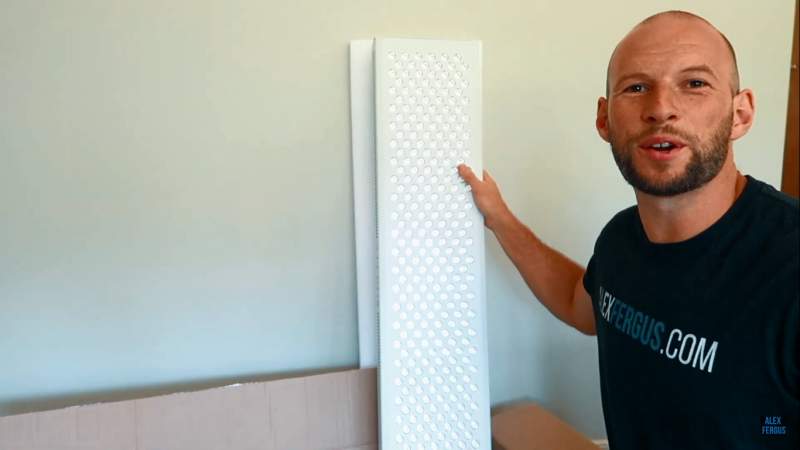
My first impression is that this is a rather solid, very heavy panel.
The look of the panel is mostly the same as the PlatinumLED BioMax units.
(I'll publish an updated review on the PlatinumLED panels soon - some YouTube videos are already visible, click HERE for the first impressions video).
Here you can see a comparison between the Mito Red MitoPRO 1500 and some other panels on the market:
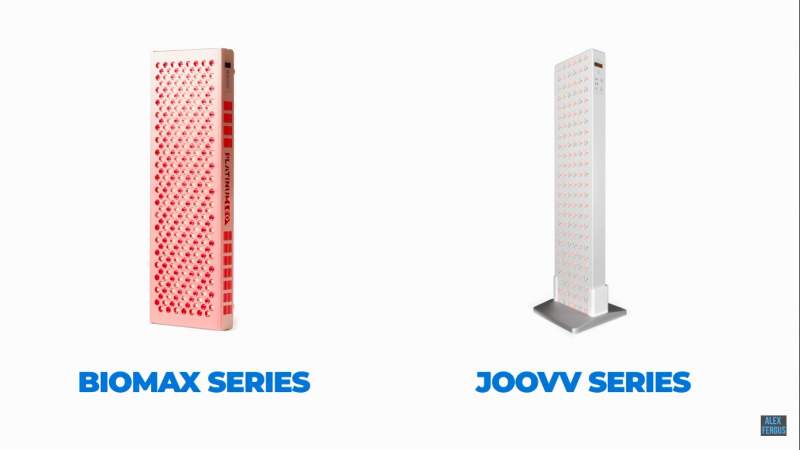
Looks pretty similar, right? Well, looks alone can be deceiving - therefore I'll explore each of these panels in great detail for you.
The looks are also slightly different. The BioMax has more of a glossy finish while the Mito Pro has more of a matte finish.
The MitoPRO 1500 has 300 LEDs built-in. These 300 LEDs use 5 Watts per LED, in theory. I'll test the true power draw in my full review, however, so you'll have to continue reading for that data!
This panel can be classed as a "body panel". In my classification system, panels with up to 300 LEDs are "body panels". Panels with 301 LEDs or more I classify as "mega panels".
If you want a smaller panel than the 1500, there's a panel with 150 LEDs (MitoPRO 750) and 60 LEDs (MitoPRO 300), in this series. All these panels you can order from the Mito Red website.
Moreover, here you can see the panel from the side:
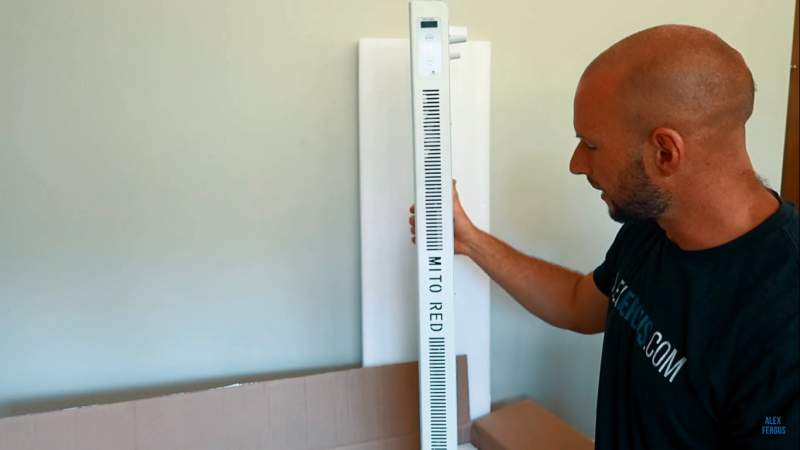
You can see the branding on the side, which all panels nowadays have. This MitoPRO panel is also a little bit thicker than the Joovv Solo 3.0 and PlatinumLED BioMax version 1.
Also, at top of the panel on the side, you can see the inbuilt control panel. The control panel contains a timer in this unit. The control panel also allows you to use red and infrared light together, or, either of them alone.
Then there's the backside with 5 fans in total (only 4 are visible on the picture):
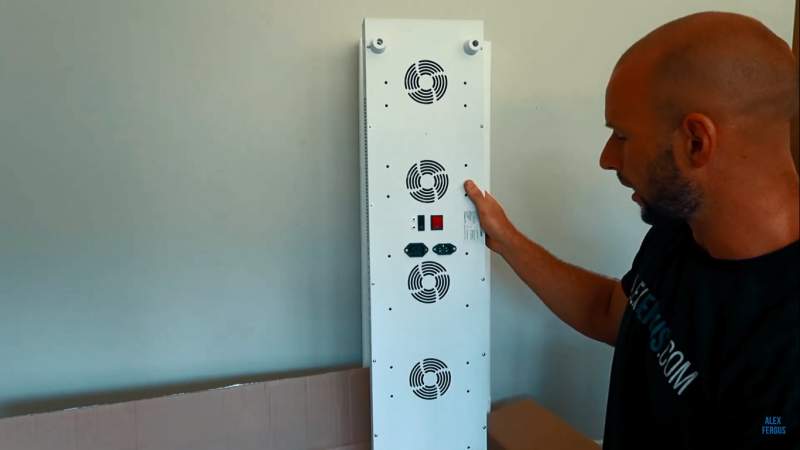
Additionally, you can probably see the thick plastic feet on it, to prevent you from damaging your wall.
Then, in the middle, there's the power button and the plug for the modular setup. The benefit of the modular setup is that you can join 2-4 panels together, cover a much greater treatment area, and activate or deactivate all panels from one control unit.
Other Ranges: The Original Range And MitoMOD Range
Mito Red offers two other panel ranges, the Original series and the MitoMOD series. The latter supports modular units while the former does not.
Here you can view the difference between these panels:

On the left, you see the Original series panels. The black panels in the middle are the MitoMOD series' units, and the ones on the right are the MitoRPO, the ones I'm reviewing right now.
The difference between the MitoMOD and MitoPRO is that the former only emits the 660 and 850nm wavelengths, while the latter emits 2 more wavelengths - 630 nm and 830 nm.
(If you don't know what "wavelengths" are or if you're not acquainted with the basic lingo of red light therapy, read my guide on everything you need to know about red light therapy.)
I've looked at the studies regarding these additional wavelengths and I do consider the 630 and 830nm beneficial. Some people in the industry don't agree with me, though.
If you want to learn about my perspective on these wavelengths, watch THIS video.
Moving on to the next topic:
What's Included In The Box
Even though this step sounds simple, many people think it's very important. Besides the panel, the following accessories are included in the box:
- A power cable that's correct for your geographical area's power plug
- The pulley system that's always included with all panels that allows you to suspend your panel up high
- One connector, for if you buy multiple panels and want to use the modular function
- Eye goggles, which I personally don't use.
- Cables for the top, which can be connected to the pulley system
- One door hook, so you can suspend your panel on a door. My doors are too thick for me to ever use that door hook so I haven't successfully tried one yet
- An instruction manual
Here you can view all these accessories:

MitoPRO 300, MitoPRO 750, And MitoPRO 1500 Differences
If you like to learn more about the MitoPRO series differences, this infographic below taken from the Mito Red website shows the differences perfectly:

I've just included it because you might have some questions about the differences. All these MitoPRO panels emit the same wavelengths and have the same features, their only difference is their size.
Moving on to another option many may be interested in:
Vertical And Horizontal Stand Options
The new MitoPRO panels also allow you to use a vertical or horizontal stand. The horizontal stand is to be sold soon but isn't yet right now.
The horizontal stand can be very useful for people who cannot stand for a long time. If you're older or have a hip injury, for instance, then laying down can be a life-saver, especially with longer use.
Here you can see a picture of the vertical stand, used with the MitoMOD option:
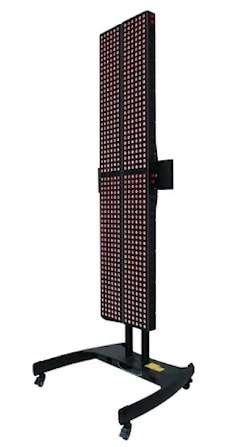
That vertical stand costs $299 right now. The vertical stand holds a total of 4 panels.
Price, Shipping, And Warranty
The MitoPRO 1500 panel costs $1,150 USD, but with discount code ALEX you can reduce that number to ~$1,100 USD.
The MitoPRO 300 costs $329 and the MitoPRO 750 costs $649, without code ALEX applied yet.
In most cases, if you can afford it, bigger panels are better. The benefit of a bigger panel is that you can treat a larger bodily area at one time and that you can cut down on treatment time a lot. Read the guide on red light therapy dosing if you want to learn more about that principle.
There's one exception: if you're only using the device to treat a smaller area of your body, such as the skin on your face, or a shoulder injury. In that case, a handheld red light therapy device can be a great option too.
Mito Red is a US-based company. That location means that shipping to non-US parts of the world increases the overall price of the product.
US shipping is currently free. Outside the US the shipping price is $100-130 USD. Shipping to Australia costs $125 and to the UK it's $120 USD.
Those shipping costs are on the higher side of the equation, compared to other companies. Those shipping costs are a bit of a bummer to me.
Lastly, the MitoPRO range also has a 3-year warranty option, unlike panels from the Original or MitoMOD series.
60-Day Return Policy With No Restocking Fee
One of the best features of this panel is the 60-day no questions asked return policy. That return policy means that you can ship your panel back to Mito Red - at your own costs, of course - within 60 days and you'll get your money back.
With the return policy, there are no questions asked and you won't have to pay a restocking fee, unlike with other companies.
Me Setting The Panel Up
This step was really easy for me. I just plugged in the power cable and the device worked like a charm after using the control panel. Here's the result:
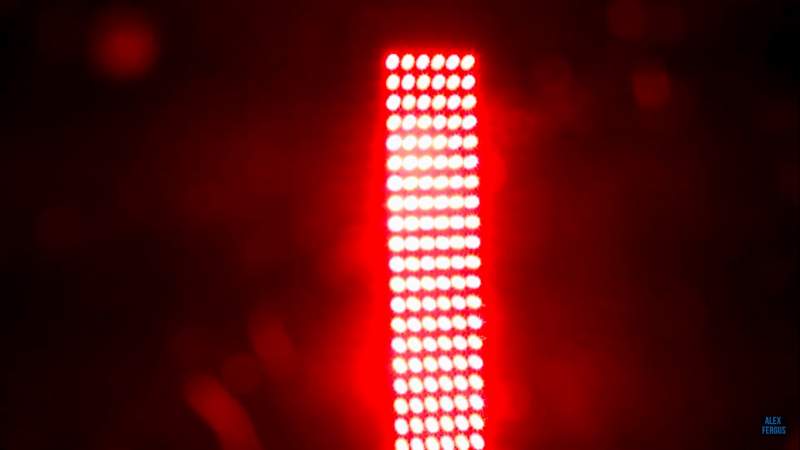
What did I notice activating the panel for the first time?
First of all, this panel is ridiculously bright. My first impression is that it looks like this is going to be a higher-powered panel. Secondly, the panel is rather quiet compared to what I'm used to.
All of these outcomes will be quantified in my full review though, so stay tuned.
Using the control panel was a little confusing for me the first time, as I read "A" and "1" on the screen:

As it later turned out, those signs mean "R" and "I", from "red light" and "infrared light". Whoops, I misunderstood this principle at first!
Check my full unboxing & first impressions video to see how I was struggling with this control panel at first.
Then there's the timer function. The timer function is very easy to use, you only have to push the timer button to add a minute to your session:
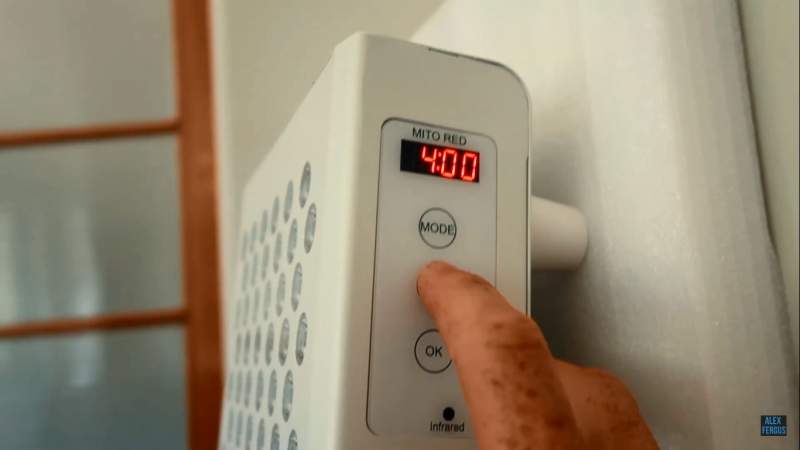
Once you hit "OK", the light will be activated.
The maximum time for a session is 20 minutes with the control panel. Of course, if you'd ever want to use a longer time, you can reactivate the panel again after 20 minutes.
And, that's it. Let's conclude this section:
First Impressions And Unboxing Conclusion
My first impressions of this red light therapy panel are really good. You've got:
- multiple wavelengths
- an inbuilt control panel
- the ability to choose between red and near-infrared (NIR) light
- modular capability
- 3-year warranty
- free US shipping
- well priced at first impression
- nicely packaged - there's branding on the box
- comes with all accessories you need
What does that outcome mean?
Well, in the past, Mito Red was the high-quality low-cost brand that performed really well in my 2019 review series (check my more recent and up-to-date buyer's guide as well).
I think that Mito Red has continued that trend while adding some new bells and whistles at the same time, such as additional wavelengths, a control panel, better warranty, etcetera.
I'm really curious to see how this panel ranks against other top-notch options such as the LightpathLED Large Multiwave Pulsed.
Many other companies will be offering some great features, though, so I'll have to see how the MitoPRO 1500 holds up against the competition in my more recent reviews.
Want to know a lot more about this panel? In that case, let's move on to my very much in-depth full review:
Mito Red MitoPRO 1500 Full Review: An Excellent Panel At Excellent Value?
So, welcome to my in-depth review of the MitoPRO 1500. In this section, I'll review this panel with extreme detail.
I've also published a YouTube video review that lasts almost an hour. You can watch that YouTube video below:
If you'd rather read the review, just keep scrolling down and I'll break down all the details of this panel. I'll consider the wavelengths emitted by a spectrometer, EMF emissions, different measurements of power output, value metrics such as price per LED, and much more.
Let's begin with the basics:
Physical Properties: Size, Power Connection, And Color
From a size perspective, the panel is 42 inches tall (~107 centimeters), 10 inches wide (~25 centimeters), and 3 inches thick (~8 centimeters).
The rubber feet which I've mentioned before make the panel ~2 inches thicker, if you'd want to include them in the measurement.
The only downside about the physical properties is that the power cable is inserted in about the middle of the panel. The consequence is, that if you hang the panel up high, your power cable might not be long enough and you might need a power extender. I would have rather preferred to have the power output at the lower end of the panel so that the power cable isn't too short as quickly.
(I'm assuming here that most power outlets are located at floor level!)
Lastly, the panel is exclusively available in the white-matte color that you see in the pictures above. No other color is available. I do think the color is very good looking, but, with Mito Red you don't have the ability to choose a color, unlike some other companies on the market right now.
Weight Of The Red Light Therapy Panel
The panel weighs 25 pounds, which is about 11 kilograms.
The downside here is that there are no handheld grips, even though some other new panels do have these grips. If you're an older person, for instance, the handheld grips are a real lifesaver for moving the panel around.
In some cases, you'll have to move the panel, such as for treating your upper body. The easier the panel is to move, the less of a problem for an older or injured person that process will be.
All companies will eventually probably catch up with the grips/handles, but right now, Mito Red has not yet done so.
Instruction Manual Quality
The instruction manual looks quite good. Most of the information in that manual is pulled directly from the website.
However, the instruction manual looks way better than that of some other companies. Some other companies have very minimalistic manuals or they're only one page or only provide a link to the website for instructions. If you're buying a $1,000+ product, I think it's more than fair to include a decent manual with the product, but that's my view.
Here you can view the MitoPRO manual:
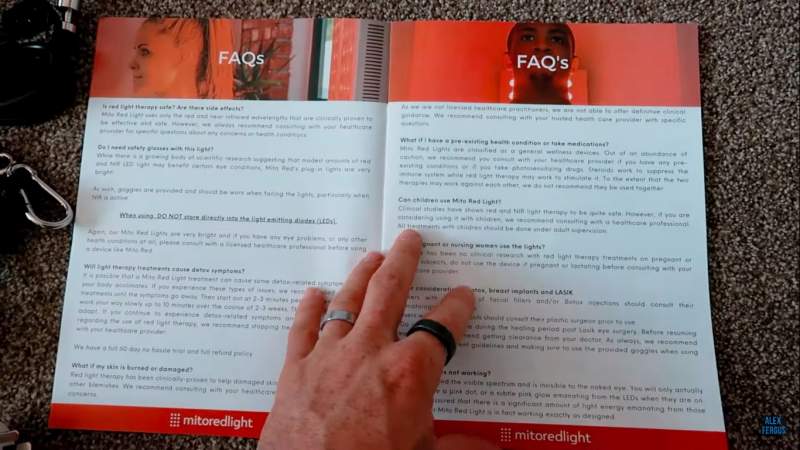
Especially for the red light therapy beginner, the manuals are really nice. This manual contains some basic information about red light therapy, how to set the panels up, how to use the modular capability, and so forth.
So, now that I've got all of these basics out of the way, let's move on to the fun part of the review:
Spectrometer Wavelength Testing
For this review, I've used the Hopoo Color 0HSP-350F - 380-1050nm Spectrometer for this process.
As mentioned before, there are 300 5 Watt LEDs within this panel. These LEDs are "single-diode" LEDs and have a 60-degree beam angle.
"Single-diode" means that only 1 wavelength can be emitted from that one diode. With dual-chip LEDs, you can divide the power that goes to different wavelengths of your choice.
Personally, I like 30-60 degree wavelengths are best. 90-degrees is too wide, in my opinion (although the term can be confusing as there are multiple ways of measuring this principle!)
Remember that the panel contains 4 wavelengths: 630nm, 660nm, 830nm, and 850nm. Mito Red claims that power is equally distributed across these wavelengths, so each should receive 25% of the power.
As a comparison, the PlatinumLED BioMax has 5 wavelengths, but 80% of power still goes to 660nm and 850nm. The 3 remaining wavelengths therefore only receive ~7% each, which is quite low, arguably.
There is also a benefit to PlatinumLED's approach because the 660nm and 850nm wavelengths have more scientific evidence behind them.
Also, the LightpathLED has 5 wavelengths in total, which is another unique approach. Read my LightpathLED review if you'd like to learn more.
With that background in mind, I've started testing the wavelengths in both the red and NIR part of the light spectrum, against Mito Red's claims. First up, the red part of the range, with my spectrometer. Here you can see the red peaks:
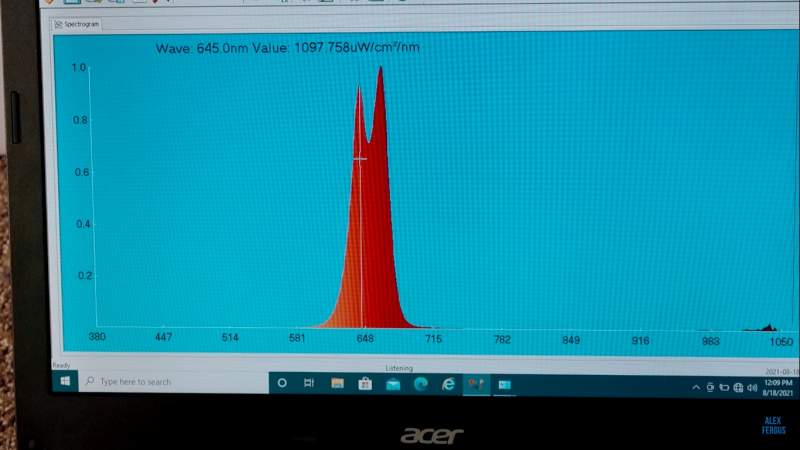
See anything special?
Yes! The red part of the spectrum doesn't peak around 630 nanometers but peaks at 645 nm instead. That's a huge discrepancy, to me, and suboptimal.
I've taken several readings across the panel and I consistently got the same outcome. I've also tested several spots on the panel to be sure.
Next up, here's the peak that should be around 660 nm:
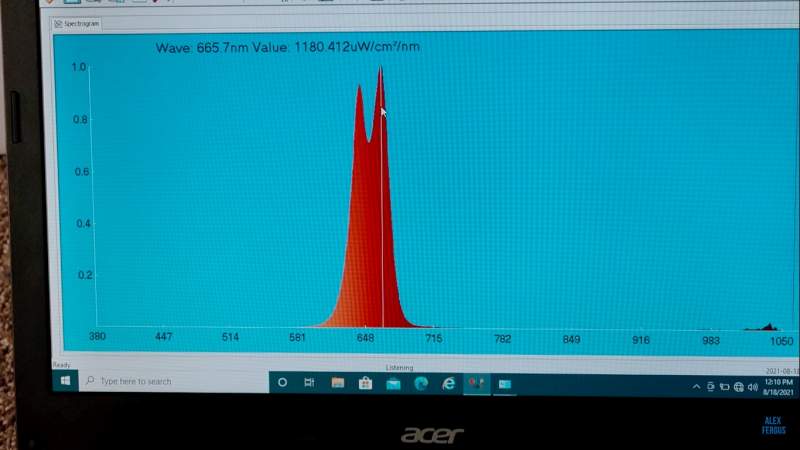
The actual peak - according to my spectrometer - is found around 665 nm, which is quite good. If you look at the curve, you're still getting quite some power output at 660 nm, so this one is pretty decent.
Because of the 645 nm wavelength output, there's a bit of a discrepancy between the claimed wavelength output and reality.
Next up, there's the NIR range. Here's the peak that should be around 830 nm:
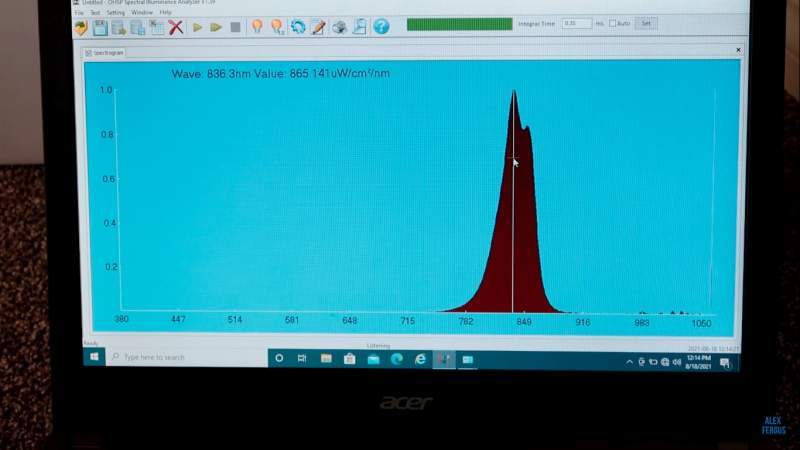
Peaking around 836 nm on my spectrometer, the outcome aligns decently well with Mito Red's claims.
Next up, here's the peak that I've tested in the 850 nm range:

The 851 nm peak matches up almost perfectly with 850 nm. Let's consider what Mito Red had to say about this outcome:
Mito Red's Response To My Testing Results
I reached out to Mito Red about the 830-nanometer anomaly I found. Mito Red responded that they normally don't have this issue, and that they've rigorously tested their panels and that normally, the 830 nm should align up decently well with the outcome I get on my spectrometer.
The difference between Mito Red's outcome and my readings may have been because I got a testing panel.
Also, Mito Red even had a third-party lab test their wavelength outputs, so they were quite surprised with my findings.
Lastly, due to a manufacturing defect during some period, some of the wavelengths might not have aligned. I've unfortunately received such a panel.
Power Output (Irradiance) Testing & Wattage Draw From Power Outlet
In this section, I measure peak power at 6 inches for red light and NIR light. I've use my spectrometer for that, once again. I also combined the power outputs and I create an estimate of the total power output per panel.
Here you can see me live in action with my spectrometer testing:
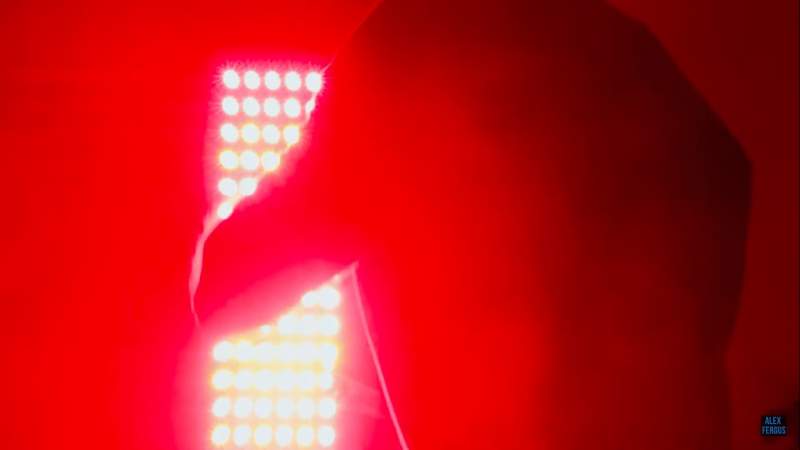
Here's the outcome of that testing:
- peak power at 6-inches: 88.2 mW/cm2. That outcome is quite good although it's not the highest power output. This is the maximum output of light I get on my spectrometer by moving it across a range of LEDs
- red light peak power - from 6 inches again - at 47 mW/cm2.
- near-infrared peak power at 44 mW/cm2, this time with only NIR activated.
- total power output: 136 Watts. For that total power output, I use the size of the panel and the earlier readings
- average power output across 9 spots: 76 mW/cm2. the average power output reading is by averaging 9 different readings from different parts of the panel and then using the size of the LED projection area to create an estimate.
These first 3 numbers are a bit lower than the LightpathLED Large Multiwave Pulsed, which scored 48 mW/cm2 and 50 mW/cm2.
The total power output of 136 W, however, is the highest I've ever seen so far, so that's great! The LightpathLED total power output is 120 W, but, that panel only has 255 LEDs, not 300 like the MitoPRO 1500.
I've also done some wattage draw testing, with a meter I place between the power outlet and the red light therapy panel. The outcomes are:
- red light: 390 W
- near-infrared: 425 W
- total wattage draw: 806 W
So, if you've got the MitoPRO panel on with both red and infrared light, your power outlet is consuming 806 Watts in total. It's quite likely that a higher wattage draw is also a sign that your panel emits more light.
Moving on:
Hotspot Testing
With hotspot testing, I look at whether the power output of a panel is distributed evenly. I test for hotspots at a 6-inch distance, because that's the recommended distance to use most panels at if you want a higher dose:
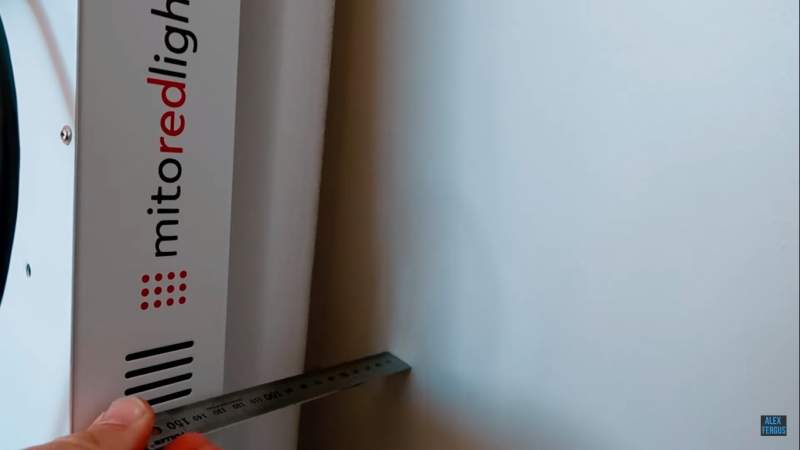
Here's the outcome of that 6-inch distance hotspot testing:

Overall, that hotspot outcome looks really good. You can see the dropoff at the edges of the panel, and you don't see any massive peaks or a polka dot effect.
I've seen some shocking outcomes and this one is really great.
Value Calculation: USD Per LED And USD Per Watt
Next up, I'm going to calculate the value about what you're getting from this panel.
First up, the price per LED is the price in USD you pay for each LED. Next up, the price in USD per Watt signifies how much you're paying per quantity of power output. I've applied discount code ALEX to both these calculations.
Simple, right?
Here are the outcomes:
- Price per LED: $3.64. That outcome is really great and that's the lowest figure I've seen across 4 panels from big companies I've tested.
- Price per Watt: $8.02. This calculation is based off the 136 W total Wattage output figure I've used earlier. This outcome of $8.02 USD with discount code ALEX is insanely good and also the lowest so far.
So, even though the MitoPRO 1500 doesn't have the highest power output of all panels, it still comes out really well in the value domain. This outcome is similar to the pattern I observed in my 2019 review.
(A full comparison of all body panels, much more than I've tested so far, will be published soon. Click HERE to subscribe to my newsletter and get updates on my red light therapy reviews).
Moving on to the next topic, an important one...
EMF:
Electrosmog (EMF): Radio Waves, Magnetic Fields, Electric Fields
For this test, I use the Cornet EMF meter . That meter has great accuracy and reliability against much more expensive meters that run into the thousands of $USD. I've actually had EMF experts come to my house and compare that meter against their much more expensive models and the Cornet did great.
So here's the outcome of the EMF testing:
- radiowaves at 6 inches: nonexistent. All perfect, and none to be expected either as the panel doesn't have any Bluetooth function.
- magnetic fields at 6 inches: 0.06 microTesla. That outcome is located within the green part of the equation, of the building biology standards.
- electric fields at 6 inches: 9 V/m, which is rock-bottom low and great too.
Overall, this outcome is perfect.
Sounds And Noise Pollution Exposure
If you don't understand why noise matters, Bart from this team has written an excellent guide on noise pollution. For instance, you can read up on what noise pollution is, all the different science-backed health effects of noise pollution, and how to lower your exposure to noise.
Here's the outcome of my decibel meter test:
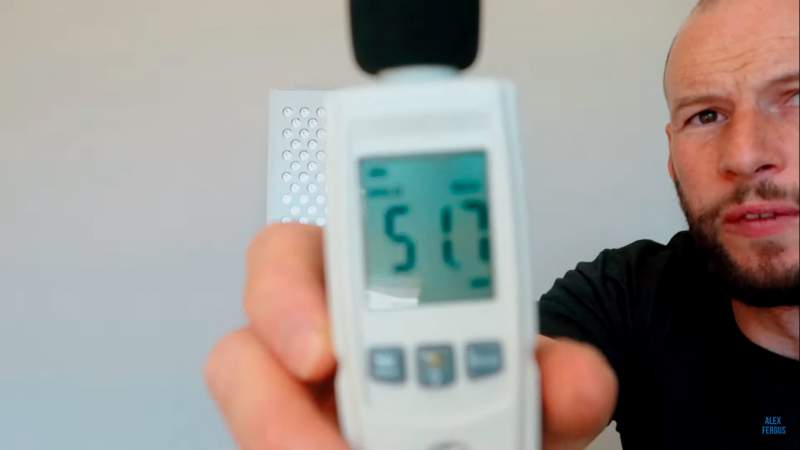
That 51.7 decibels (dB) is pretty good, overall.
Flicker And Pulsing Levels
The older Mito Red panels had quite some flicker. The flicker rate was 100 Hz and a flicker % of 71%. For the new unit I can be very abridged, as there is no flicker in this new panel. It's very interesting how Mito Red improved their engineering here!
I've tested for flicker with my Spectrometer, once again. I haven't included a picture because you've gotten used to seeing pictures of my spectrometer so far.
If you don't understand the topic of flicker, read my blog post about the flicker and health. Lastly, there's the issue of ease of use:
Ease Of Setting Up The Panel
The process of setting up the panel is pretty easy. You insert the power cable into the red light therapy unit and into the wall, push the OK button, and the panel starts.
If necessary, you can use the mode button to activate or deactivate one part of the light spectrum.
In this domain, it's a win once again. There's no fancy control panel or anything extraordinary you have to do with the cables.
The control panel, although it was somewhat confusing to me in the beginning, does become easy to use after you've tried it a few times.
One issue that does exist is that the light for the infrared light isn't too clear in notifying you whether the infrared light is on or off. In fact, if you turn the panel on, by default, infrared is switched off!
And, because I recommend using both infrared and red light for 90%+ people, it's not the best engineering to switch infrared light off automatically. You'll therefore have to activate infrared light each time you plug in the power, and if you don't, then you might only notice later that the infrared isn't activated.
Your eyes cannot see infrared light, so you cannot visually see whether infrared light is activated.
My Experience After A Few Weeks Of Use
Here are my findings after a few weeks of use and a few dozen sessions:
- I love how simple the panel is, it's easy to turn on, although the infrared doesn't come on automatically
- The size is quite nice and I like the tallness of the panel
- I feel good after using this panel and get the benefits I usually get from red light therapy, such as reductions in jaw/tooth pain
- Overall, I'm quite happy with this panel
Let's consider how I'd rate this panel compared to other Mito Red panels:
MitoPRO Comparison To Mito Red Original Series and MItoMOD Series
After a few weeks of use, I decided to compare the panel against the Original Series and the MitoMOD series again, as these are the other offerings from the MIto Red company.
Both the series have different size panels. Here's what I think:
- MitoPRO 1500 versus MitoMOD 900: the MitoMOD 900 is the biggest panel from that range. The MitoMOD 900 has 180 LEDs compared to 300 for the MitoPRO 1500. The MitoMOD is also a lot smaller than the MitoPRO 1500. And yes, the MitoMOD 900 is $400 cheaper, but, you miss out on a few key features. One feature missing from the MitoMOD 900 is the additional wavelengths, the control panel, and the panel is smaller. This option is harder to justify for me, from a value perspective, because the MitoPRO 1500 is almost double the size. The MitoMOD 900 also has a 2-year warranty period instead of 3 years
- MitoPRO 1500 versus MitoMEGA: the MitoMEGA also has 300 5W LEDs and is therefore rated at 1500W total. The MitoMEGA price is $999, without code ALEX applied yet, and therefore just over $100 USD cheaper than the MitoPRO 1500. But, you get a lot of extra functions on the MitoPRO 1500, such as modular capability, more wavelengths, higher power output, better warranty, a control panel, and more. So, because of the very small price difference, the MitoMEGA from the Original Series is very hard to justify, for me, as well. The MitoPRO 1500 is the clear winner from Mito Red, for me, right now. The PRO panels even look better to me.
Overall, the MitoPRO 1500 is thus the big winner in Mito Red's offerings!
Hope that helps...
Next up, comparing the MitoPRO 1500 to the competition:
Comparing The MitoPRO To Competitors (PlatinumLED BioMax, LIghtpathLED Large Multiwave Pulsed, Etc)
Here's what I think comparing the Mito Red MitoPRO to competitors' products:
- MitoPRO 1500 versus PlatinumLED BioMax 900: both panels are absolutely amazing, and both panels also came at the first place during my 2019 review. It's very hard for me to choose between the panels because the Mito panel has been upgraded substantially since 2019, with new wavelengths, a control panel, and more. however, the BioMax has also been upgraded and I'll do some more extensive testing soon and compare both panels side by side. For now, it's impossible for me to pick a winner. I like the wavelength distribution across the panel for the MitoPRO, for instance, but I love the control panel for the BioMax with additional customizability.
- MitoPRO 1500 versus Joovv Solo 3.0: once more, another tough comparison. Joovv is probably the biggest red light therapy company out there and their new Solo 3.0 unit has some great new features - watch my YouTube first impressions video with the Solo 3.0 HERE. The Joovv Solo only has 150 LEDs though and only emits the 660 nm and 850 nm wavelengths. However, the Joovv Solo has got some other cool features making up for the other downsides. From a value perspective though, I think the MitoPRO `500 is far superior to the Joovv Solo 3.0
Takeaway? Wait a bit longer until I do more in-depth reviews of all these panels and you'll learn which I think is best...
Next up, let's consider my final likes and dislikes of this panel:
Concluding Likes & Dislikes After Rigorous Testing
Now, lastly, let's consider in more detail what I like about this panel and what I dislike:
- Like: great value. So far to date, this is the best value red light therapy panel out there, as measured in price per Watt when using discount code ALEX. Most people aren't interested in the more advanced features such as the pulsing in the LightpathLED or the advanced features in the Joovv 3.0 anyway, so for them this value panel is great.
- Like: 60-day trial period with no restocking fee. This benefit is huge, and not often included by the competition. With many competitors, you pay a 10% or 20% restocking fee, which can be hundreds of USD added on top of the costs to ship the panel back.
- Like: four wavelengths, evenly spread. I quite like the four wavelengths approach and also like that they all receive 25% of the total power output. The power within these wavelengths is also decent, even though it's not the highest power that I've measured.
- Dislike: misses a few bells and whilstes. Compared to other offerings such as the Joovv 3.0 and LightpathLED Large Multiwave Pulsed panel, you do miss out on a few extra options such as pulsing or wireless connectivity. Also, there's no 810 nanometer wavelength within this panel, which some may miss because of its effect on cognitive function. The misalignment of 830, which I tested at 845 nm, is another bummer.
- Dislike: international shipping costs outside US. For some people, paying an extra $100-130 for shipping to the EU or New Zealand will be a turnoff.
- Dislike: boring and bland? The MitoPRO 1500 does the basic stuff really well, but doesn't do anything else exceptionally. If you're an advanced biohacker, you might think this panel is a bit bland. Nonetheless, Mito Red have positioned themselves as doing the basics really well, and for 80% of people out there buying a red light therapy panel, that's all you need!
That's it...
Lastly, let's move on to my conclusion:
Finishing Thoughts: An Extraordinary Panel For Ordinary People
Most people in life just want it simple: stand in front of a panel for 4-5 days a week, for 20 minutes, and get their results.
The average person doesn't care about intellectual discussions about whether 810 nanometers is better than 830, or whether both should be included.
It's the same for a car: the average person just wants a product that works and looks good. That's it.
The MitoPRO 1500 offers some extraordinary quality for the ordinary person. With the lowest discounted price per Watt, good support, and good wavelengths.
I think the panel will do really well during my 2021 review series on red light therapy. To stay updated on that review series, as well as my continuous reviews on red light therapy, check my red light therapy buyer's guide and the associated Excel sheet containing data of all my reviews.
I'm also really looking forward to comparing this MitoPRO 1500 to the new and upgraded BioMax 900 and testing the latter more extensively. Much more content coming up! Stay tuned!
Update: YouTube Review Comparing The PlatinumLED BioMax 900 And The Mito Red MitoPRO 1500
Check out my YouTube comparison of the PlatinumLED BioMax 900 and the Mito Red MitoPRO 1500 here:
Items Mentioned
- Hopoo Color 0HSP-350F - 380-1050nm Spectrometer
- Mito Red Mito Mobile Flex - discount code ALEX saves
- LightPathLED Large Multiwave Pulse - discount code ALEX saves
- PlatinumLED BioMax 900 - discount code ALEX saves
- MitoRed MitoPro 1500 - discount code ALEX saves
- Cornet EMF meter
Found This Post on Red Light Therapy Interesting? Then You Might Like:
- The Ultimate Red Light Therapy Buyers Guide
- Red Light Therapy Resource & Discounts Page
- 36 Powerful Red Light Therapy Benefits
- Everything You Need To Know About Red Light Therapy Dosing
- How Does Red Light Therapy Work? Physics, Photons & Physiology 101
- The Best Handheld Red Light Therapy Device Of 2021: Epic Review
- How Blue Light Is Ruining Sleep And Making You Sick Fat And Tired (And How To Fix It)
This blog post was written by Alex Fergus. Alex is a ISSN Sports Nutrition Specialist, Fitness Professional and certified Superhuman Coach who continues to expand his knowledge base and help people across the world with their health and wellness. Alex is recognized as the National Record Holder in Powerlifting and Indoor Rowing and has earned the title of the Australian National Natural Bodybuilding Champion. Having worked as a health coach and personal trainer for over a decade, Alex now researches all things health and wellness and shares his findings on this blog. Learn more about Alex's Credentials HERE.
Get FREE Updates & EXCLUSIVE Content
Join Over 30,000+ Subscribers!


